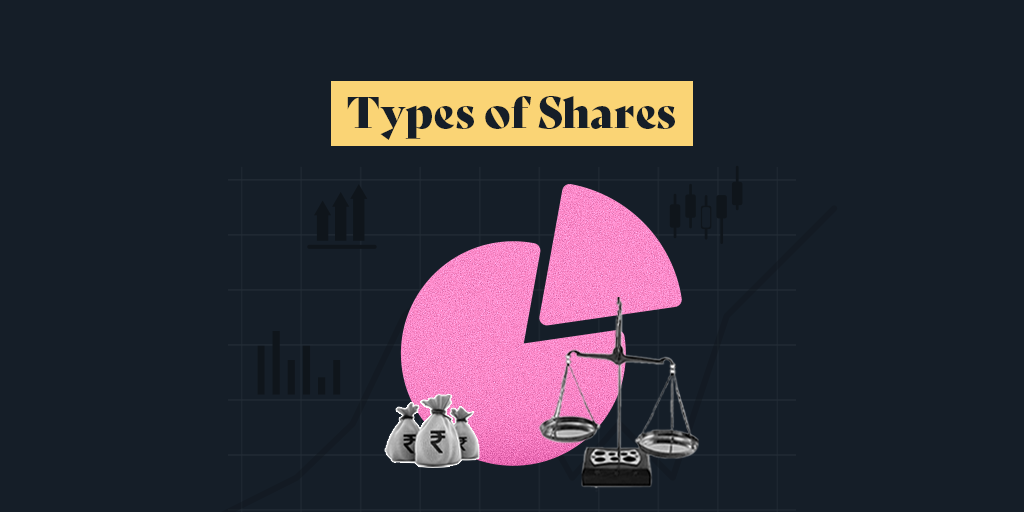Last Updated on Jan 2, 2023 by Aradhana Gotur
A company can raise capital in two ways: by borrowing and issuing shares. In this article, we discuss what are shares and the types of shares.
This article covers:
- What are shares?
- Types of shares
- Equity shares meaning
- Types of equity shares based on the features
- Types of equity shares based on returns
- Preference shares meaning
- Types of preference shares
Table of Contents
What are shares?
When you buy/hold shares of a company, you become an investor/shareholder. A share gives you a stake or part ownership in the company, making you a part-owner of the company. Apart from ownership, a share also offers other entitlements to shareholders such as voting rights, preferential rights, participation in surplus profits, rights to receive dividends, and so on. These entitlements or benefits depend on the types of shares in question. Now that you know what a share is, let us look at the various types of shares that a company can issue.
Types of shares
Shares are classified into two broad categories:
- Equity shares
- Preference shares
Equity shares meaning
Also known as ordinary shares, equity shares give ownership rights to shareholders. By virtue of this, you are entitled to receive dividends, which are part of the company’s profits. However, the dividend payment is not guaranteed by a company. This is because the company can only declare dividends to equity shareholders after meeting other obligations out of the profits.
In addition to dividends, you are also entitled to participate in the company’s surplus profits (over and above dividends). The surplus is what remains after the company makes all the payments it was obligated to out of the profits including dividends paid to preference shareholders. Similarly, as a part-owner of the company, you are also required to partake in its losses limited to your stake.
In addition to ownership rights, equity shares also give voting rights to shareholders. Generally, one share denotes one vote but this can differ based on the company’s policies. As an equity shareholder, you can also attend the general and annual meetings of a company and exercise your voting rights during the election of directors and review of company policies.
Equity shares are transferable and are traded actively in a stock market. You can make money by buying equity shares at a lower price and selling them at an inflated price in a stock market. Now that you are familiar with equity shares meaning, let’s take a look at the types of equity shares.
Types of equity shares based on the features
- Bonus shares
- Rights shares
- Sweat equity shares
- Voting shares and non-voting shares
Bonus shares
These are additional shares that a company issues to its existing shareholders free of cost. Bonus shares are issued instead of offering monetary compensation for dividends or to convert some of the company’s retained earnings into equity shares.
Rights shares
Also known as a rights issue, rights shares give existing equity shareholders a right to buy new shares at a discounted price. In other words, shareholders can either exercise this right and buy new shares or revoke the right and not subscribe at all. Rights shares are available for subscription before they are open for trade to potential investors. Ergo, as an existing shareholder, you are required to buy such equity within the stipulated time. You can read more about the rights issue in this article we have written.
Sweat equity shares
These are offered to employees of a company as a reward for their significant contribution or service. Offering sweat equity is a great way to retain efficient employees as it gives them a stake in the company’s ownership. To get a better understanding of this type of equity, read our article on sweat equity shares.
Voting shares and non-voting shares
In general, most equity shares give voting rights to investors. However, equity shares give differential voting rights or don’t give any voting rights to the shareholders. These are called non-voting shares.
Types of equity shares based on returns
- Dividend stocks
- Growth stocks
- Value stocks
Dividend stocks
These are dividends paid by a company in the form of new shares. Dividend stocks are issued on a pro-rata basis.
Growth stocks
These are issued by companies having a high potential for growth. Growth stocks may or may not offer dividends but owning them can help wealth creation via capital appreciation.
Value stocks
These are stocks that trade at a price lower than their intrinsic value in the markets. The price of such shares is expected to appreciate gradually, making value stocks attractive investment propositions for investors with a long-term investment horizon.
Now that you are familiar with the various types of equity shares, let us understand what preference shares are.
Preference shares meaning
Like equity shares, preference shares also offer ownership rights to investors. In addition, they give you preferential rights over other shareholders. For instance, while preferential shareholders are guaranteed a fixed dividend, they are entitled to receive it on priority, before the ordinary shareholders.
Also, in the event of winding up of a company, preference shareholders are entitled to receive their dues before equity shareholders. However, such shareholders can’t partake in a company’s surplus profits. Preference shares also don’t entail voting rights.
Types of preference shares
- Cumulative preference shares and non-cumulative preference shares
- Participating preference shares and non-participating preference shares
- Convertible preference shares and non-convertible preference shares
- Redeemable preference shares and irredeemable preference shares
Cumulative preference shares and non-cumulative preference shares
Cumulative preference shares give shareholders the right to receive the arrears of dividend before other investors. Meaning, if a company doesn’t pay dividends to preference shareholders in a given year, it will be carried forward to the next year. In contrast, non-cumulative preference shares don’t enjoy such benefits. If a company makes inadequate profits during a year and fails to pay dividends, then it cannot be recovered in the subsequent years.
Participating preference shares and non-participating preference shares
Holders of participating preference shares are entitled to partake in the surplus profits of a company after the equity shareholders are paid dividends. This is in addition to guaranteed dividends. On the other hand, holders of non-participating preference shares are only eligible to receive a fixed dividend and cannot partake in the surplus profit.
Convertible preference shares and non-convertible preference shares
Subject to the conditions laid down in the Articles of Association (AoA) of the company, convertible preference shares can be converted into equity shares. However, non-convertible preference shares can’t be converted into equity shares.
Redeemable preference shares and irredeemable preference shares
Redeemable shares can be claimed or repurchased by the issuing company at a fixed price at a later date. In contrast, irredeemable preference shares can’t be repurchased by the company.
We hope this article on various types of shares has made you better equipped to make informed investment decisions.
- Best Performing Index Funds in India (2025) - Jun 5, 2025
- Issue of Shares – Meaning, Types, Examples and Steps - Jun 4, 2025
- Banking Mergers in India – List of Merged PSU Banks, Advantages, and Challenges - Jun 3, 2025





